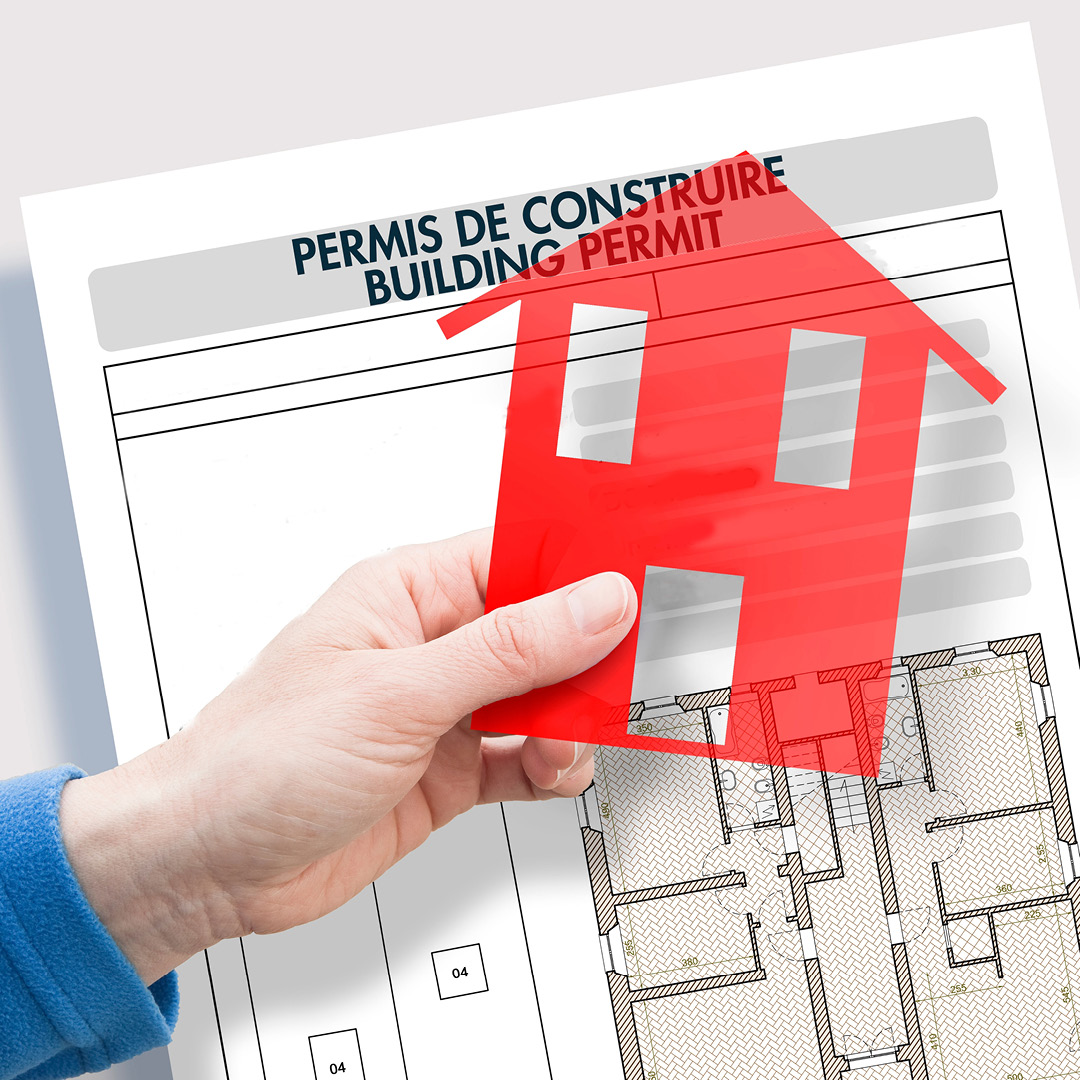
In February, the total value of building permits issued in Canada increased by $371.3 million (+2.9%) to $13.1 billion. Gains in construction intentions were led by British Columbia's non-residential sector.
On a constant dollar basis (2017=100), the total value of building permits issued in February grew 3.2% from the previous month and was up 5.6% on a year-over-year basis.
Chart 1: Total value of building permits, seasonally adjusted
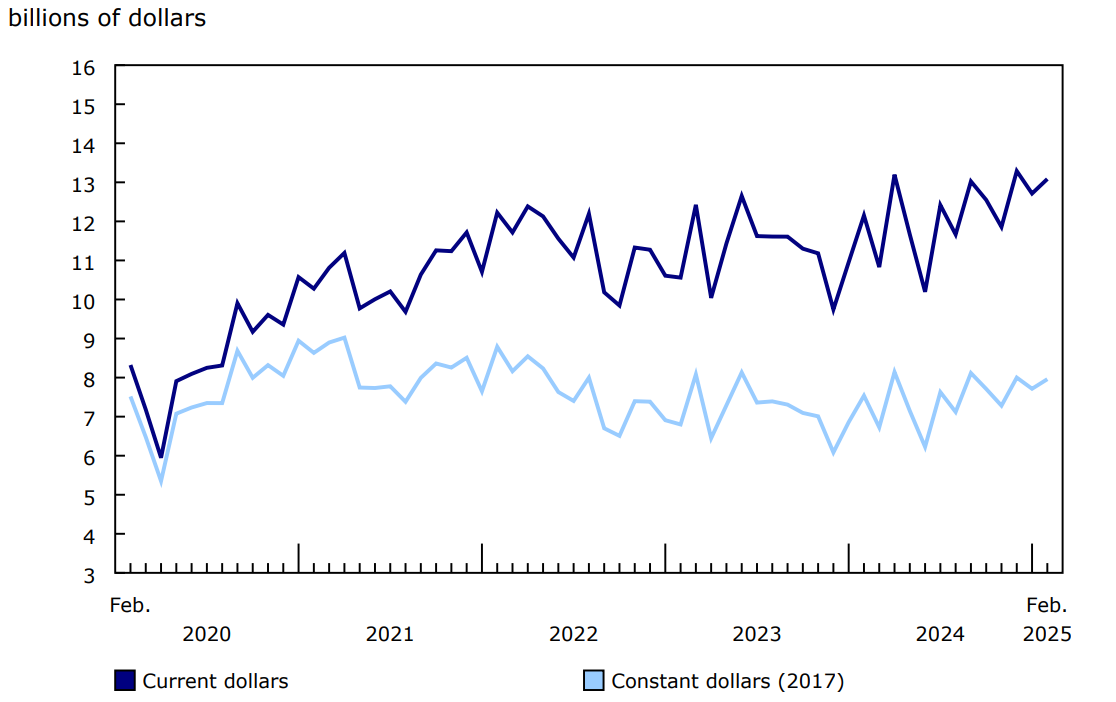
Description - Chart 1
Data table: Total value of building permits, seasonally adjusted
Source: Table 34-10-0285-01.
Figure 1: Month-to-month change in total value of building permits (seasonally adjusted, current dollars)
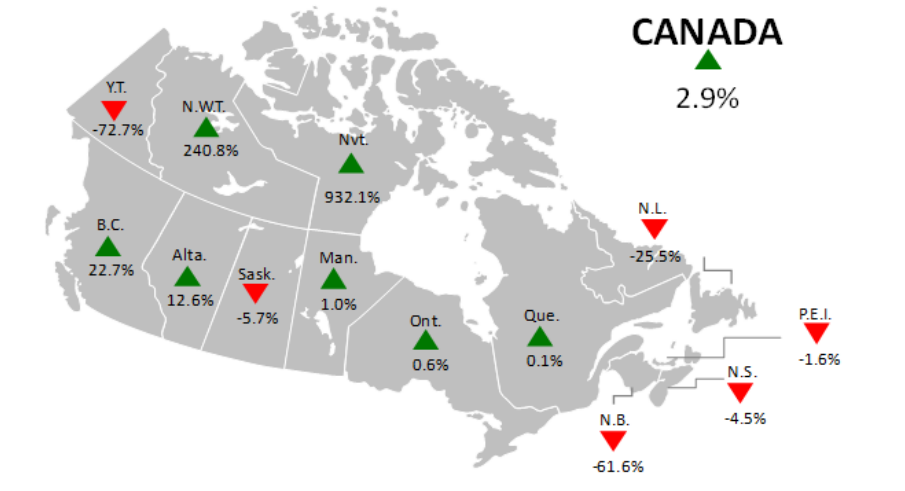
Description - Figure 1
The title of Figure 1 is Month-to-month change in total value of building permits (seasonally adjusted, current dollars).
This is a map of Canada by province and territory that shows the month-to-month percentage changes of the total building permits value. Green arrows represent an increase, while red arrows represent a decrease.
Building permit values in Canada up 2.9% in February compared with January. Newfoundland and Labrador down 25.5%, Prince Edward Island down 1.6%, Nova Scotia down 4.5%, New Brunswick down 61.6%, Quebec up 0.1%, Ontario up 0.6%, Manitoba up 1.0%, Saskatchewan down 5.7%, Alberta up 12.6%, British Columbia up 22.7%, Yukon down 72.7%, Northwest Territories up 240.8%, Nunavut up 932.1%.
Figure 2: Building permits for residential and non-residential construction in Canada (seasonally adjusted, current dollars)

Description - Figure 2
The title of Figure 2 is Building permits for residential and non-residential construction in Canada (seasonally adjusted, current dollars).
Residential: The total value was down 2.9% month over month.
Non-residential: The total value was up 15.3% month over month.
Single-family dwellings: the total value was $2,959 million, representing a month-over-month decrease of 0.8% or $22.6 million.
Multi-family dwellings: the total value was $5,457 million, representing a month-over-month decrease of 4.0% or $224.8 million.
Industrial: the total value was $783 million, representing a month-over-month increase of 12.4% or $86.2 million.
Commercial: the total value was $2,586 million, representing a month-over-month increase of 22.9% or $481.8 million.
Institutional: the total value was $1,300 million, representing a month-over-month increase of 4.1% or $50.7 million.
Source: Table 34-10-0285-01, Building permits, by type of building and type of work.
British Columbia's construction intentions lead the growth in the non-residential sector
The national value of non-residential building permits increased by $618.7 million (+15.3%) to $4.7 billion in February, rebounding after four consecutive months of declines. British Columbia's non-residential sector (+$657.7 million) led the growth, supported by gains in the commercial (+$390.0 million) and institutional (+$248.8 million) components. Major projects in the Vancouver census metropolitan area (CMA) significantly contributed to gains for the province's commercial and institutional components.
The growth in Canada's non-residential sector was spread across its three components in February, with gains in the commercial (+$481.8 million), industrial (+$86.2 million) and institutional (+$50.7 million) subsectors. The industrial component ticked up in February 2025, after trending downward since September 2024. In the summer of 2024, the industrial component drove the non-residential sector to a quarterly series high in the third quarter of the year.
Chart 2: Value of building permits for the single-family and multi-family components
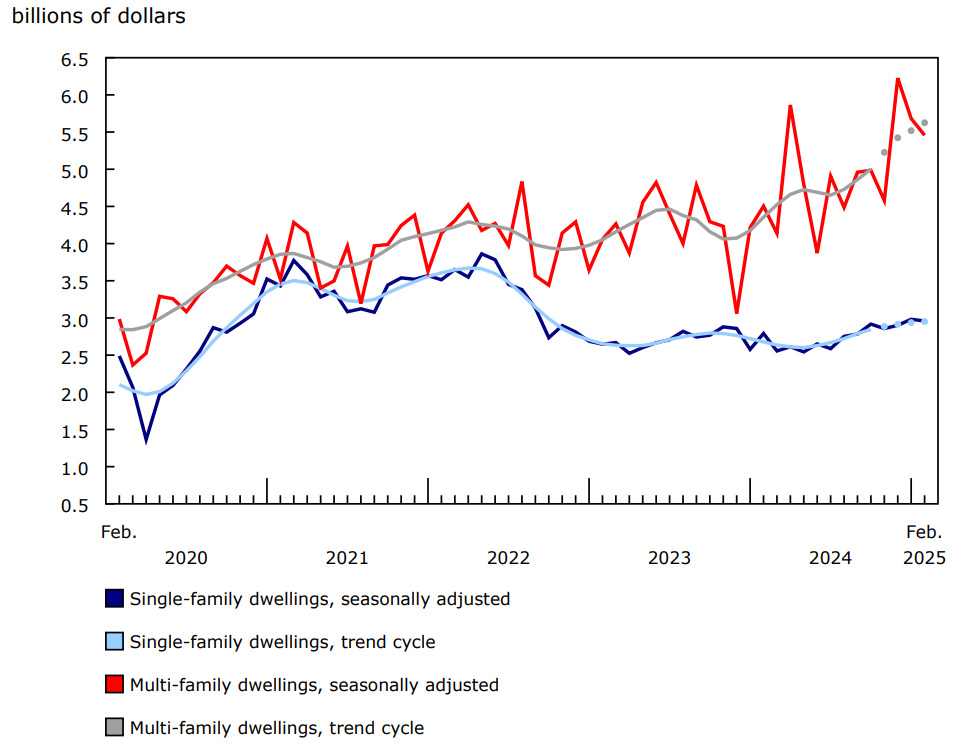
Description - Chart 2
Data table: Value of building permits for the single-family and multi-family components
Notes: The higher variability associated with the trend-cycle estimates is indicated with a dotted line on the chart for the current reference month and the previous three months. For more information, see the Note to readers.
Source: Table 34-10-0285-01.
Chart 3: Value of building permits for the residential and non-residential sectors
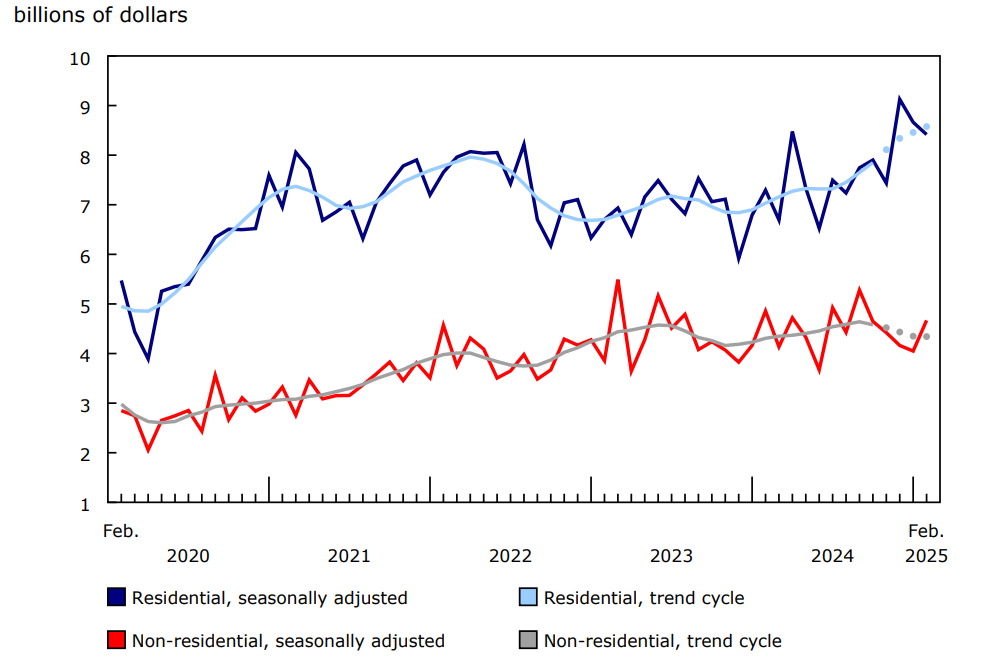
Description - Chart 3
Data table: Value of building permits for the residential and non-residential sectors
Notes: The higher variability associated with the trend-cycle estimates is indicated with a dotted line on the chart for the current reference month and the previous three months. For more information, see the Note to readers.
Source: Table 34-10-0285-01.
Chart 4: Value of building permits for the industrial, commercial and institutional components
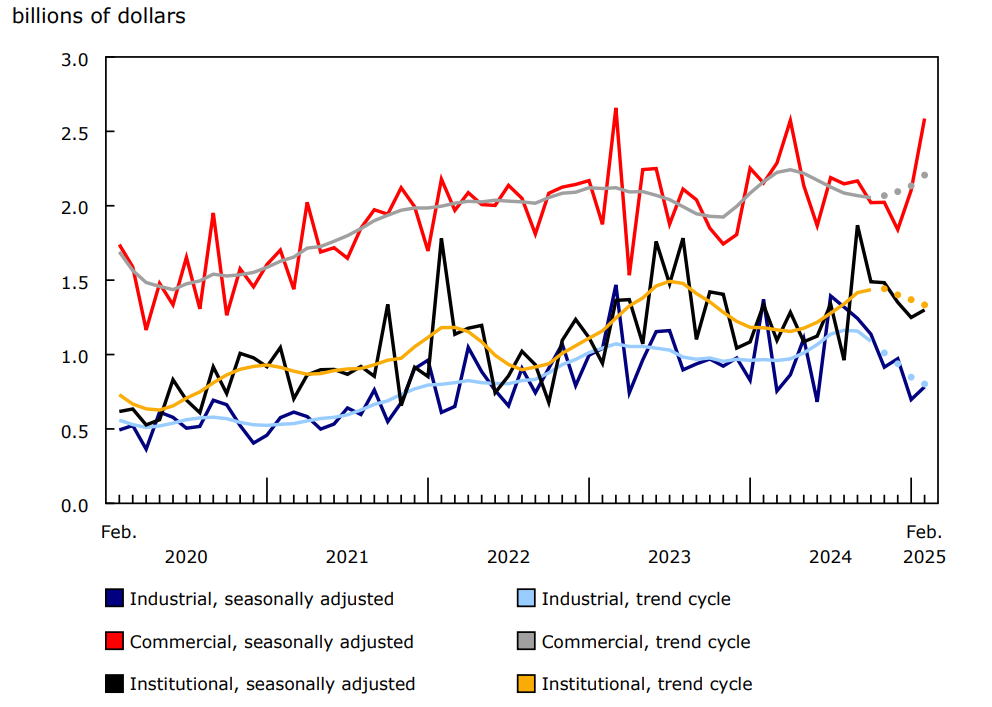
Description - Chart 4
Data table: Value of building permits for the industrial, commercial and institutional components
Notes: The higher variability associated with the trend-cycle estimates is indicated with a dotted line on the chart for the current reference month and the previous three months. For more information, see the Note to readers.
Source: Table 34-10-0285-01.
British Columbia's multi-family component drives the residential sector decline
Canada's residential construction intentions declined by $247.4 million (-2.9%) to $8.4 billion in February 2025. Overall, the multi-family component fell by $224.8 million, while the single-family component decreased by $22.6 million.
British Columbia's multi-family component (-$185.5 million) led the decline, with decreases concentrated in the Vancouver CMA. Quebec (-$131.5 million) and New Brunswick (-$105.4 million) contributed to the residential sector decrease in February, after helping to offset losses in the national residential sector the previous month. Quebec's residential sector decline was driven by the multi-family component (-$107.9 million) and supported by the single-family component (-$23.6 million). New Brunswick's residential sector decrease was led by the multi-family component (-$103.3 million). The decrease in the national residential sector was mitigated by Ontario (+$110.2 million).
Across Canada, 21,000 multi-family dwellings and 4,800 single-family dwellings were authorized in February, down 7.1% from the previous month.
To explore data using an interactive user interface, visit the Building permits: Interactive Dashboard.
For more information on construction, please visit the Construction statistics portal.
For more information on housing, please visit the Housing statistics portal.
Table 2: Value of building permits, by province and territory – Seasonally adjusted
Table 3: Value of building permits, by census metropolitan area – Seasonally adjusted
Note to readers
Unless otherwise stated, this release presents seasonally adjusted data with current dollar values, which facilitate month-to-month and quarter-to-quarter comparisons by removing the effects of seasonal variations. For information on seasonal adjustment, see Seasonally adjusted data – Frequently asked questions.
For information on trend-cycle data, see the page Trend-cycle estimates – Frequently asked questions.
Data may not add up to totals as a result of rounding.
Table 34-10-0285 will be archived and replaced by table 34-10-0292 with the April 2025 reference period, which will be released on June 11, 2025. Data from January 2018 onwards, previously available in table 34-10-0285, remains accessible in the new table, with the exception of the constant dollar series, which will be rebased to 2023 = 100.
Building components
- Single-family dwellings: Residential buildings containing only one dwelling unit (e.g., single-detached house, bungalow, linked home [linked at the foundation]).
- Multi-family dwellings: Residential buildings containing multiple dwelling units (e.g., apartment, apartment condominium, row house, semi-detached house).
- Industrial buildings: Buildings used in the processing or production of goods or related to transportation and communication.
- Commercial buildings: Buildings used in the trade or distribution of goods and services, including office buildings.
- Institutional and government buildings: Buildings used to house public and semi-public services, such as those related to health and welfare, education or public administration, and buildings used for religious services.
Revision
Data are subject to revisions based on late responses, methodological changes and classification updates. Unadjusted data have been revised for the previous month. Seasonally adjusted data have been revised for the previous three months.
Reference
Data table: 34-10-0285-01.
- Note: some data tables may best be viewed on desktop.
Definitions, data sources and methods: survey number 2802.
Previous release: Building permits, January 2025.
Next release: May 14, 2025.
Contact information
For more information, or to enquire about the concepts, methods or data quality of this release, contact us (toll-free 1-800-263-1136; 514-283-8300; infostats@statcan.gc.ca) or Media Relations (statcan.mediahotline-ligneinfomedias.statcan@statcan.gc.ca).